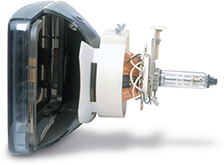Analog Signals
An analog signal is a smoothly varying signal produced by continuously changing the voltage or current in a circuit. Information is encoded in the strength or frequency of the analog signal. Figure 17A shows one familiar example a signal used by an AM radio station. The music is encoded as a smoothly changing pattern of the voltage.
Digital Signals
A digital signal encodes information as a string of 1's and 0's. Figure 17B shows how pulsing a current on and off can produce a digital signal. When the current is off, it represents a “0.” When the current is on, it represents a “1.” You may be familiar with Morse code, which in a similar way uses two signals. A dot and a dash are all you need to represent the 26 letters of the alphabet and the digits 0 through 9.
Digital signals are more reliable than analog signals. For example, a DVD, or digital video disc, encodes digital signals as a series of pits in the DVD surface. If a pit is damaged, it is often still readable as a 0 or a 1. The quality of video is not affected unless the damage is severe. In comparison, damage to an analog videotape adds noise to the signal.
Figure 17 Electronic signals convey information by changing voltage or current in a circuit.
A An analog signal can be produced by smoothly changing voltage. B A digital signal can be produced by pulsing a current on and off. Applying Concepts Could a portable radio, in theory, receive and process a digital signal?

Vacuum Tubes
To create an electronic signal, you must be able to control the flow of electrons. A vacuum tube was used to control electron flow in early electronic devices.  Vacuum tubes can change alternating current into direct current, increase the strength of a signal, or turn a current on or off.
Vacuum tubes can change alternating current into direct current, increase the strength of a signal, or turn a current on or off.
One useful type of vacuum tube is a cathode-ray tube (CRT) shown in Figure 18. Many computer monitors and televisions contain CRTs. One side of the CRT has three metal plates that emit electron beams. The electrons are emitted at one end of an airless tube and strike a glass surface on the other end. The glass is coated with phosphors that glow red, green, or blue in response to the electron beams. An electronic signal controls the strength and position of the beams to produce images with the light from the phosphors.
Although vacuum tubes have many useful features, some types burn out frequently and need to be replaced. They are also much too large for use in small electronic devices.
Figure 18 A cathode-ray tube is still used in many computer monitors and television sets.






